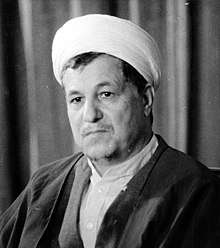Presidency of Akbar Hashemi Rafsanjani
Presidency of Akbar Hashemi Rafsanjani was the 5th and 6th government of Iran after Iranian Revolution. At that time, Akbar Hashemi Rafsanjani was the president.
 | |
| Presidency of Akbar Hashemi Rafsanjani | |
|---|---|
| 16 August 1989 – 3 August 1997 | |
| President | Akbar Hashemi Rafsanjani |
| Cabinet | First cabinet, Second cabinet |
| Party | Combatant Clergy |
| Election | 1989, 1993 |
| Seat | Pasteur St. Building |
| Seal of the president | |
Rafsanjani's Presidency
Rafsanjani adopted an "economy-first" policy, supporting a privatization policy against leftist economic tendencies in the Islamic Republic.[1] Another source describes his administration as "economically liberal, politically authoritarian, and philosophically traditional" which put him in confrontation with more radical deputies in the majority in the Majles of Iran.[2]
Domestic policy
Rafsanjani advocated a free-market economy. With the state's coffers full, Rafsanjani pursued an economic liberalisation policy.[3] Rafsanjani's support for a deal with the United States over Iran's nuclear programme and his free-market economic policies contrasted with Mahmoud Ahmadinejad and his allies, who advocate maintaining a hard line against Western intervention in the Middle East while pursuing a policy of economic redistribution to Iran's poor.[4] By espousing World Bank inspired structural adjustment policies, Rafsanjani desired a modern industrial-based economy integrated into the global economy.[5]
Rafsanjani urged universities to cooperate with industries. Turning to the quick pace of developments in today's world, he said that with "the world constantly changing, we should adjust ourselves to the conditions of our lifetime and make decisions according to present circumstances".[6] Among the projects he initiated are Islamic Azad University.[7][8]
During his presidency, a period in which Rafsanjani is described by western media sources as having been the most powerful figure in Iran, the judicial system of Iran executed political dissidents, drug offenders, Communists, Kurds, Bahá'ís, and clerics.[9]
Foreign policy
Following years of deterioration in foreign relations under Khomeini during the Iran-Iraq war, Rafsanjani sought to rebuild ties among Arab states,[10] as well as with countries in Central Asia, including Azerbaijan, Turkmenistan and Kazakhstan.[11] However, relations with European countries and the United States remained poor, even though Rafsanjani has a track record of handling difficult situations and defusing crises.[12]
He condemned both the United States and Iraq during the Persian Gulf War in 1991. After the war he strove to renew close ties with the West, although he refused to lift Khomeini's fatwa against the British author Salman Rushdie.[13]
Rafsanjani has said that Iran is ready to assist Iraq, "expecting nothing in return". On the other hand, he has said that "peace and stability" is a function of the "evacuation of the occupiers."[14]
Iran gave humanitarian help to the victims of the conflict. Iran sent truck loads of food and medicine to Iraq and thousands of Kuwaiti refugees were given shelters in Iran.[15]
Rafsanjani voiced support to Prince Abdullah's peace initiative and to "everything the Palestinians agree to". He was also clear that Iran's international interests must take precedence over those of Iranian allies in Syria and Lebanon.[12]
Rafsanjani is a supporter of Iran's nuclear program. In 2007 Rafsanjani reiterated that the use of weapons of mass destruction was not part of the Islamic Republic culture. Rafsanjani said: "You [US and allies] are saying that you cannot trust Iran would not use its nuclear achievements in the military industries, but we are ready to give you full assurances in this respect." [16]
Currency crisis
During 1990–95, Rafsanjani's administration faced the brunt of the second-generation US economic sanctions. He failed to stop the Iranian rial from plunging 80% in value from 415 to 2,046 to the US dollar, triggering the rise of the modern underground and barter economic networks.
Members of the cabinet
| Portfolio | Minister | Took office | Left office | Party | |||||
|---|---|---|---|---|---|---|---|---|---|
| Presidential Administration | |||||||||
| President | Akbar Hashemi Rafsanjani | 16 August 1989 | 3 August 1997 | CCA | |||||
| First Vice President | Hassan Habibi | 21 August 1989 | 3 August 1997 | ECP | |||||
| Chief of Staff | Mohammad Mir-Mohammadi | August 1989 | 16 February 1994 | Nonpartisan | |||||
| Hossein Marashi | 1994 | 1996 | ECP | ||||||
| Mohsen Hashemi Rafsanjani | 29 May 1996 | August 1997 | ECP | ||||||
| Ministers | |||||||||
| Agriculture Minister | Issa Kalantari | 29 August 1989 | 20 August 1997 | ECP | |||||
| Communications Minister | Mohammad Gharazi | 29 August 1989 | 20 August 1997 | ECP | |||||
| Commerce Minister | Yahya Ale Eshaq | 29 August 1989 | 16 August 1993 | ICP | |||||
| Abdolhossein Vahaji | 16 August 1993 | 20 August 1997 | Nonpartisan | ||||||
| Construction Minister | Gholamreza Forouzesh | 29 August 1989 | 20 August 1997 | ECP | |||||
| Cooperatives Minister | Gholamreza Shafeei | 29 August 1989 | 20 August 1997 | ECP | |||||
| Culture Minister | Mohammad Khatami | 29 August 1989 | 24 May 1992 | ACC | |||||
| Ali Larijani | 16 July 1992 | 15 February 1994 | ICP | ||||||
| Mostafa Mirsalim | 22 February 1994 | 20 August 1997 | ICP | ||||||
| Defence Minister | Akbar Torkan | 29 August 1989 | 16 August 1993 | ECP | |||||
| Mohammad Forouzandeh | 16 August 1993 | 20 August 1997 | Military | ||||||
| Finance Minister | Mohsen Nourbakhsh | 29 August 1989 | 16 August 1993 | ECP | |||||
| Abdolhossein Vahaji* | 17 August 1993 | 6 October 1993 | Nonpartisan | ||||||
| Morteza Mohammadkhan | 6 October 1993 | 20 August 1997 | ECP | ||||||
| Education Minister | Mohammad-Ali Najafi | 29 August 1989 | 20 August 1997 | ECP | |||||
| Energy Minister | Bijan Namdar Zanganeh | 29 August 1989 | 20 August 1997 | ECP | |||||
| Foreign Minister | Ali Akbar Velayati | 29 August 1989 | 20 August 1997 | ICP | |||||
| Health Minister | Iradj Fazel | 29 August 1989 | 13 January 1991 | Nonpartisan | |||||
| Reza Malekzadeh | 13 January 1991 | 16 August 1993 | ECP | ||||||
| Alireza Marandi | 16 August 1993 | 20 August 1997 | ICP | ||||||
| Housing Minister | Serajeddin Kazerouni | 29 August 1989 | 16 August 1993 | Nonpartisan | |||||
| Abbas Ahmad Akhoundi | 16 August 1993 | 20 August 1997 | Nonpartisan | ||||||
| Roads Minister | Mohammad Saeedikia | 29 August 1989 | 16 August 1993 | Nonpartisan | |||||
| Akbar Torkan | 16 August 1993 | 20 August 1997 | ECP | ||||||
| Mines and Metals Minister | Hossein Mahlouji | 29 August 1989 | 20 August 1997 | ECP | |||||
| Light Industries Minister | Mohammadreza Nematzadeh | 29 August 1989 | 20 August 1997 | ECP | |||||
| Heavy Industries Minister | Hadi Nejadhosseinian | 29 August 1989 | 20 August 1997 | ECP | |||||
| Intelligence Minister | Ali Fallahian | 29 August 1989 | 20 August 1997 | CCA | |||||
| Interior Minister | Abdollah Nouri | 29 August 1989 | 16 August 1993 | ACC | |||||
| Ali Mohammad Besharati | 16 August 1993 | 20 August 1997 | Nonpartisan | ||||||
| Justice Minister | Mohammad Ismaeil Shooshtari | 29 August 1989 | 20 August 1997 | ECP | |||||
| Labour Minister | Hossein Kamali | 29 August 1989 | 20 August 1997 | WH | |||||
| Petroleum Minister | Gholamreza Aghazadeh | 20 August 1989 | 20 August 1997 | ECP | |||||
| Higher Education Minister | Mostafa Moeen | 29 August 1989 | 16 August 1993 | AIMSI | |||||
| Mohammad-Reza Hashemi | 16 August 1993 | 20 August 1997 | Nonpartisan | ||||||
| Other cabinet-level officials | |||||||||
| Physical Education Vice President | Hassan Ghafourifard | September 1989 | 16 February 1994 | ICP | |||||
| Mostafa Hashemitaba | 16 February 1994 | 23 August 1997 | ECP | ||||||
| Atomic Energy Vice President | Reza Amrollahi | 16 August 1989 | 3 September 1997 | ECP | |||||
| Environment Vice President | Hadi Manafi | 16 August 1989 | 23 August 1997 | Nonpartisan | |||||
| Executive Vice President | Hamid Mirzadeh | 1989 | 1994 | Nonpartisan | |||||
| Mohammad Hashemi Rafsanjani | 1994 | 1997 | ECP | ||||||
| Legal and Parliamentary Vice President | Ataollah Mohajerani | 21 August 1989 | 23 August 1997 | ECP | |||||
| Plan and Budget Vice President | Masoud Roghani | 1989 | 1994 | Nonpartisan | |||||
| Hamid Mirzadeh | 1994 | 1997 | Nonpartisan | ||||||
| Administrative Vice President | Mansour Razavi | 16 August 1989 | 16 February 1994 | ECP | |||||
| Mohammad Mir-Mohammadi | 16 February 1994 | 23 August 1997 | Nonpartisan | ||||||
| Economic Vice President | Mohsen Nourbakhsh | August 1993 | 14 September 1994 | ECP | |||||
References
- Pasri, Trita, Treacherous Alliance : the secret dealings of Israel, Iran and the United States, Yale University Press, 2007, p.132
- Brumberg, Daniel, Reinventing Khomeini : The Struggle for Reform in Iran, University of Chicago Press, 2001, p.153
- Rafsanjani's political life reviewed — in Persian.
- "Voice of ambition". The Guardian. London. 2006-06-23. Retrieved 2010-05-04.
- Book: Factional politics in post-Khomeini Iran By Mehdi Moslem
- Rafsanjani urges universities to cooperate with industries - Irna Archived 2007-09-29 at the Wayback Machine
- Rafsanjani to Ahmadinejad: We Will Not Back Down (ROOZ :: English) Archived 2007-10-30 at the Wayback Machine
- يادگارهاي مديريت 16 ساله :: RajaNews.Com :: Archived 2007-03-13 at the Wayback Machine
- Sciolino, Elaine (July 19, 2009), "Iranian Critic Quotes Khomeini Principles", New York Times
- Mafinezam, Alidad and Aria Mehrabi, Iran and its Place Among Nations, Greenwood, 2008, p.37
- Mohaddessin, Mohammad, Islamic Fundamentalism, Anmol, 2003, pp.70-72
- Al-Ahram Weekly | Region | Showdown in Tehran Archived 2007-01-12 at the Wayback Machine
- Ali Akbar Hashemi Rafsanjani Biography - Biography.com
- Iran ready for comprehensive assistance to Iraqi nation - Rafsanjani - Irna Archived 2007-01-14 at the Wayback Machine
- Book: Iran's Persian Gulf policy: from Khomeini to Khatami. By Christin Marschall
- Rafsanjani reassures West Iran not after A-bomb
See also
| Presidential terms of Iran | ||
|---|---|---|
| Preceded by Presidency of Khamenei |
Presidency of Rafsanjani 1989–1997 |
Succeeded by Presidency of Khatami |
.jpg)
